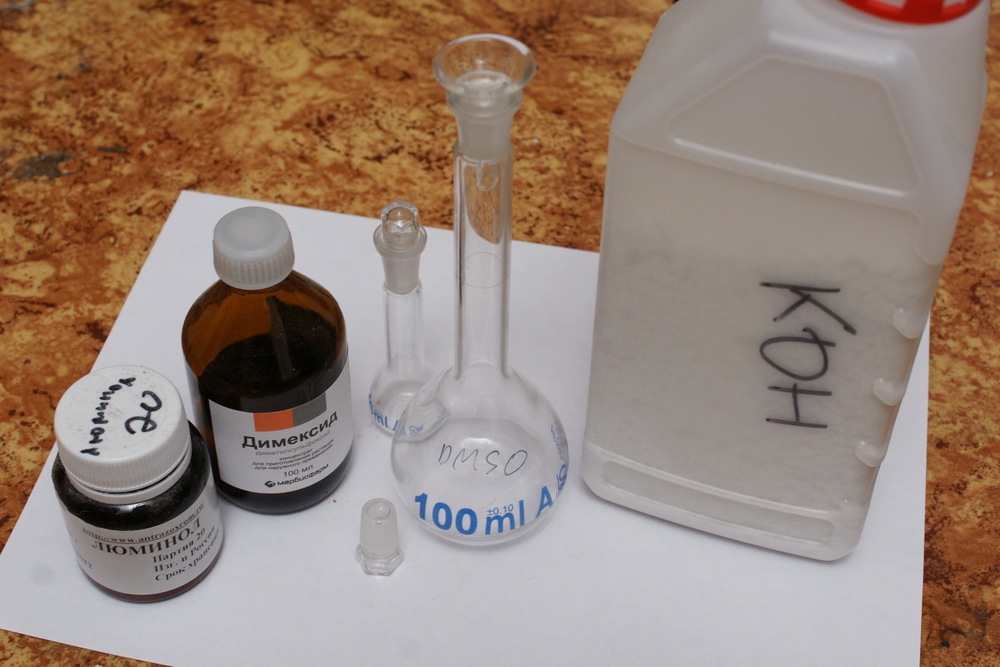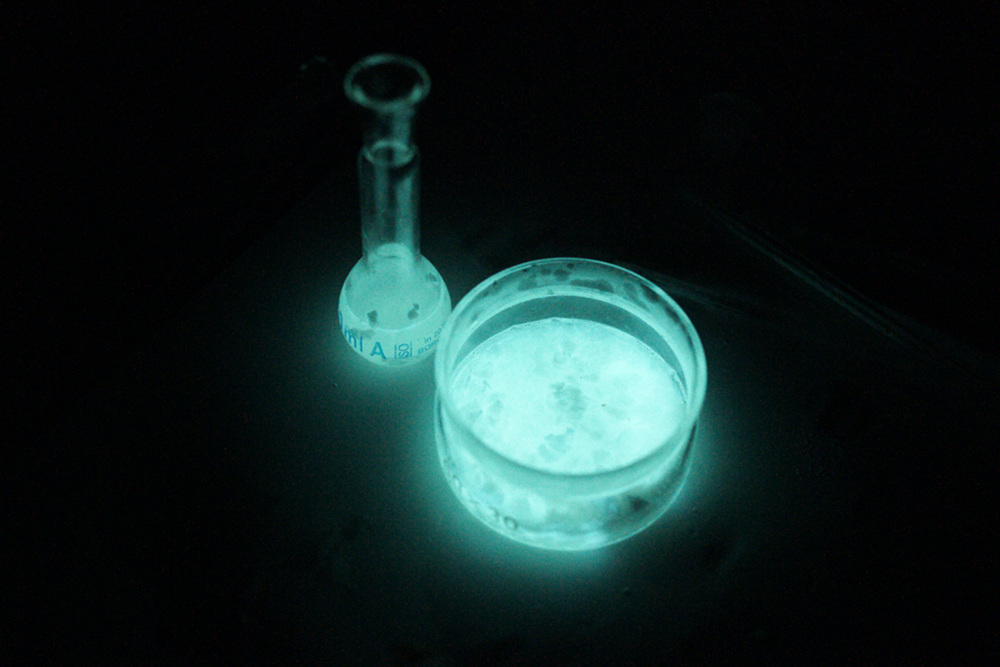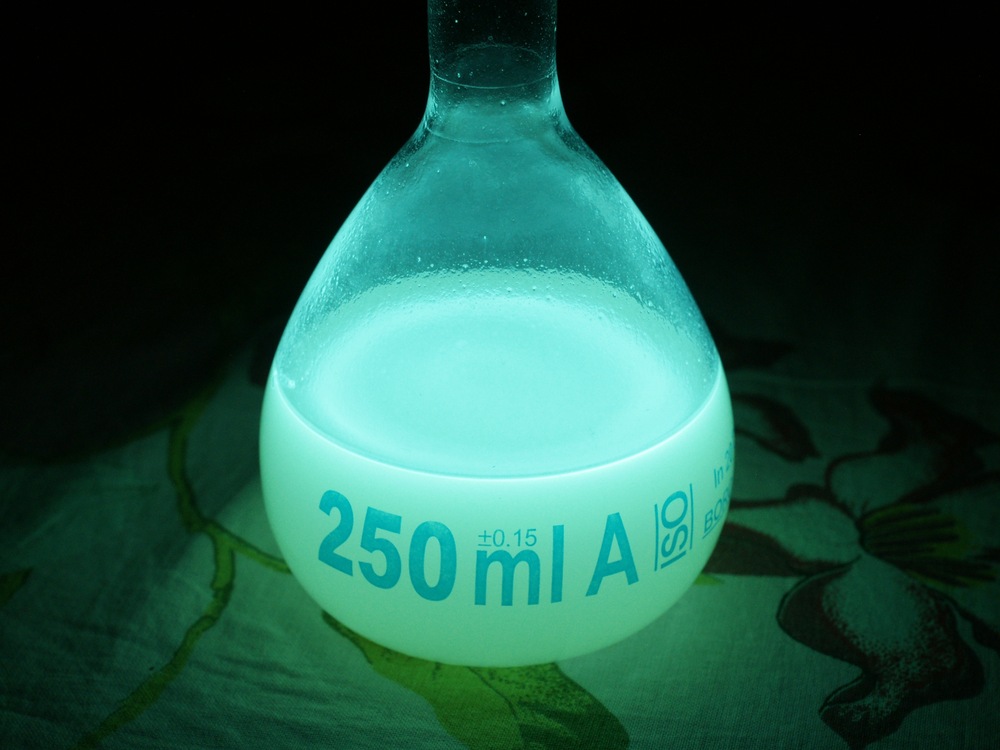Luminol chemiluminescence / what's inside the “glowing sticks”?
 Surely you have ever seen chemical light sources - glow sticks, which begin to work after the "overlapping". Inside there is a glass capsule, which breaks down and a mystical chemical reaction begins. I was always interested in how it works.
Surely you have ever seen chemical light sources - glow sticks, which begin to work after the "overlapping". Inside there is a glass capsule, which breaks down and a mystical chemical reaction begins. I was always interested in how it works.The binding energy of molecules released during a chemical reaction can be released in the form of heat (to which we are all accustomed), and in rare cases it can be in the form of radiation from a quantum of light. Light emission during a chemical reaction is called chemiluminescence. There are 2 most common reactions with chemiluminescence: Luminol oxidation and TCPO oxidation in the presence of organic dyes.
The difference is that Luminol glows itself, and TCPO transfers energy to organic dye molecules (like Rhodamine ), and thus you can control the color of the glow by choosing a dye. About TCPO (including its synthesis) can be viewed on YouTube ( using synthesis ), and the version with Luminol - under the cut.
')

What we need
First of all - Luminol. It can be found on the chemists' forums ( 1 2 ), or bought at a pharmacy called Galavit (luminol sodium salt, I have not tried this option). I found at the flea market for ~ $ 1 per gram. Do not be greedy, 1-2-3 grams is enough for experiments.Luminol is soluble only in an alkaline medium - therefore sodium hydroxide (NaOH) or potassium (KOH) is needed. Sold in a chemical store (for example Rushim).
In many examples that can be found on the Internet, the reaction with Luminol is carried out in an aqueous medium (by adding hydrogen peroxide). But the glow in this case is weak, and very short-lived (units / tens of seconds). Much better results can be achieved if dimethyl sulfoxide (DMSO) is used as a solvent, sold in a pharmacy under the name Dimexide. When working with him, you need to be careful and wear gloves - although he himself is not poisonous, it easily penetrates the skin, taking any soluble dirt on his hands with him into the blood. May have a slight unpleasant smell due to impurities, so it is better not to smell. The glow color is different by the way - in the aquatic environment it is blue, in DMSO it is turquoise. Why this happens is an interesting question.
As a source of oxygen - in the simplest case, air oxygen can be used, or hydroponic from a pharmacy. Hydrogen peroxide can not be used, because there is water.
And finally, the catalyst - in the case of DMSO, it is not mandatory, but you can try the options with blood, hematogen and horseradish juice (!). I tried with dried blood and copper sulfate - nothing good came of it. Perhaps the catalyst is only important for the reaction in an aqueous medium.

Top secret
The main difficulty is how and how much to put, so that everything works? A lot of attempts went on finding a well-working option.As it turned out, hydroxide does not happen much, and it can be taken about half the volume of DMSO, even if it does not dissolve. Luminol - by volume 1-2-3 match heads per 100ml. It is the presence of undissolved hydroxide granules - the key factor for the start of the reaction. The brightness of the glow depends on the temperature and the amount of dissolved oxygen. Without hydroperit, the luminescence very quickly remains only in the surface layer of the liquid - where there is access to air oxygen:

It is worth noting that it is difficult to judge the absolute brightness from images and videos due to the autoexposure. For example, the following example is brighter than the previous one, but because of the greater luminous mass, the exposure was shorter. In general, with such brightness you can read, although not comfortable.
If you add ~ 1g of hydraulic per 100 ml of liquid, and mix - the glow will be all over:

The glow will gradually fade, but even after 30 hours the reaction is still going on:

Finally, you can watch the video
The first frame - DMSO with dissolved luminol and KOH is poured into a flask with DMSO and potassium hydroxide at the bottom. This experiment shows the need for the presence of undissolved KOH flakes at the bottom to start the reaction.3:40 - DMSO is added to dry luminol and KOH. Immediately begins the reaction.
6.19 - the same in the "wide" capacity.
Update: A variant without hydroperit, with oxygen sparging. We look from the 40th second, oxygen - from 2.09. In this case, the DMSO was heated to ~ 60 degrees, which gave beautiful effects due to convection.
Source: https://habr.com/ru/post/184796/
All Articles